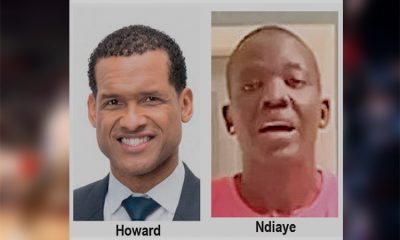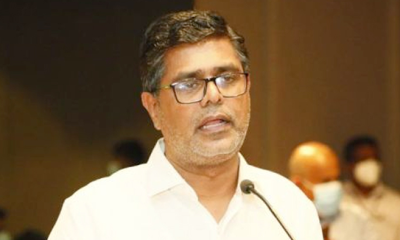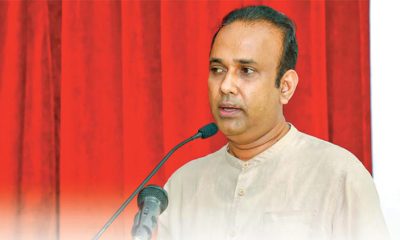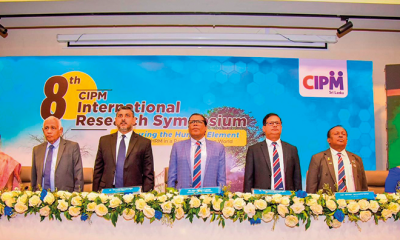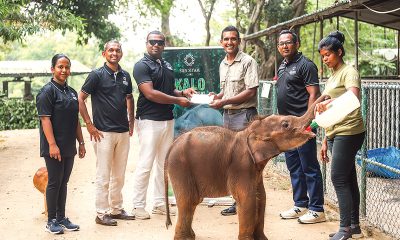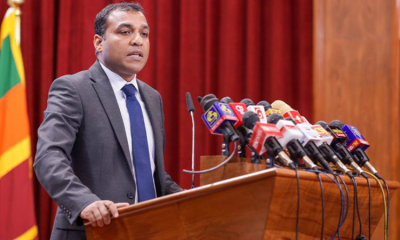News
Lanka points out flaws in Geneva process, disputes Canada’s genocide claim
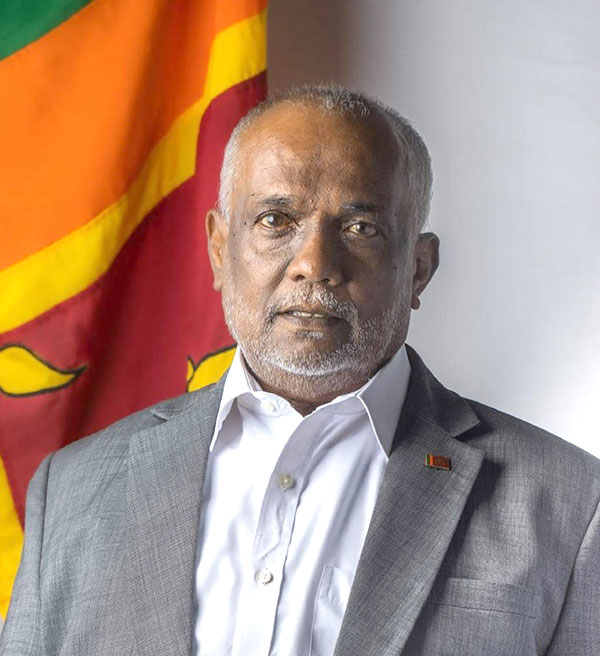
HC Navaratne responds to Ontario’s politico’s allegation 140,000 killed in Vanni war
Sri Lanka has pointed out flaws in the process adopted by the Geneva-based United Nations Human Rights Council (UNHRC) to pursue unsubstantiated war crimes accusations, which paved the way for the 2015 accountability resolution. In spite of serious concerns expressed by the then Opposition and the armed forces, the yahapalana government co-sponsored the controversial resolution against Sri Lanka.
Sri Lanka’s High Commissioner in Ottawa Harsha Kumara Navaratne has pointed out glaring inadequacies in the Geneva process exploited by interested parties, including those in Canada, to accuse Sri Lanka of causing genocide in the final phase of the conflict.
There hasn’t been a previous instance of Sri Lanka directly disputing the Geneva process since the adoption of the 2015 accountability resolution. The much-anticipated position has been taken ahead of the next Geneva sessions scheduled to begin later this month.
The following is the text of the statement titled ‘Refuting the allegation of ‘Tamil Genocide’ in the final phase of the conflict in Sri Lanka issued by the Sri Lankan mission in Ottawa requesting those interested in genuine post-war national reconciliation to initiate a dialogue with HC Navaratne: The term genocide is used to describe one of the gravest crimes against humanity, comprising of specific acts committed with intent to destroy, in whole or in part, a national, ethnical, racial or religious group. Therefore, the Sri Lanka High Commission in Canada notes with serious concern attempts by certain parties in Canada trying to portray the final phase of the conflict in Sri Lanka which ended in 2009 as ‘genocide’ against the Tamil people of Sri Lanka. The Sri Lanka community in Canada is multi-ethnic and multi-religious. In this context, the Private Member Bill 104 on ‘Tamil Genocide Education Week’ passed in Canadian province of Ontario has caused strain in intercommunity relations among the Sri Lankan community by the depiction of a false narrative against one community.
In addition, while appreciating the various Canadian Government focused programs for Sri Lankan Tamil Canadians, we are disappointed to note that on January 31, 2022, at an event announcing funding for Tamil students with targeted mental health and wellness programs and resources, Mr. Stephen Lecce, Ontario’s Minister of Education made comments including “we are very deliberate in our choice of words that we recognize a genocide that transpired against the innocent Tamil people” and “in a genocide that has left over 140,000 innocents perished at the hands of the regime in Colombo”. Mr. Vijay Thanigasalam, MPP Scarborough – Rouge Park, who was also present, referred to “Tamil genocide’ in his remarks.
We are appreciative that the Department of Foreign Affairs, Trade and Development in a
Diplomatic Note dated 7 th April 2021 responding to a clarification stated “that the Department of Foreign Affairs, Trade and Development clarify Canada’s official position with regard to allegations of genocide in Sri Lanka, the department can officially confirm that the Government of Canada has not made a finding that there was genocide in Sri Lanka”. Further, the Government of Canada has proscribed the Liberation Tamil Tigers Eelam Organisation (LTTE) as a Terrorist organization.
In this background, the repeated use of the word “Tamil Genocide” only generates dissention and prejudice amongst the children and community of Sri Lankan Canadians living in Ontario. Therefore, such allegations need to be refuted in the interest of social harmony and to prevent the spread of fallacies about Sri Lanka in the international community.
During the final phase of the conflict in Sri Lanka, the government forces confronted the internationally proscribed terrorist group Liberation Tigers of Tamil Eelam (LTTE), one of the most brutal terror groups the world has witnessed. The aim of the LTTE was to divide Sri Lanka on ethnic lines and carve out a separate State. With this objective, they conducted a three decades long terrorist campaign which brought much suffering and destruction on all communities.
During the last stages of the military conflict in 2009, when the LTTE was facing inevitable defeat, it resorted to holding Tamil civilians hostage as a human shield and refused all efforts to move civilians away from conflict areas. The allegation of civilian casualties and the exaggeration of the numbers was the means by which the LTTE sought to force foreign intervention to halt the government advance.
Nevertheless, the government forces managed to rescue approximately 290,000 Tamil civilians from the clutches of the LTTE, cared for them and resettled them. In addition, over 12,000 armed LTTE cadres were rehabilitated and released, proving thereby that the Sri Lankan government had avoided causing unnecessary deaths even among enemy combatants, not to speak of noncombatant civilians.
Therefore, there is absolutely no evidence to suggest any act and/or intent of the spurious allegations of “genocide” during the military engagement with the LTTE. Neither was there a pattern of events even to suggest “genocide”. Military experts have noted that the tactical options were justifiable and proportionate given the situation in the last phase of the military conflict.
Some parties, including LTTE remnant groups and sympathizers, have seized on hypothetical figures of civilian casualties contained in certain seriously flawed Reports commissioned by the UN, to push a claim of genocide of Tamil people in Sri Lanka during the final stage of the military conflict. However, not even the much-disputed UN Secretary General’s Panel of Experts report (PoE) carry the accusation of “genocide” against the Government of Sri Lanka. The principal findings of the OHCHR Investigation on Sri Lanka (OISL), in 2015 in to the alleged “war crimes” of Sri Lanka do not even suggest “genocide”.
Groups espousing the claim of genocide have seized the claim, made without any proof, in the PoE report “that there could have been as many as 40,000 civilian deaths” during the final months of the conflict. The PoE report came up with the hypothetical figure of 40,000 civilian deaths by setting off the actual number of people finally rescued by the Sri Lanka Army which was approximately 290,000 against the hypothetical figure of 330,000 which they deemed to be the number of civilians who had been in the area (Vanni) before military operations commenced in that region. This hypothetical number of 330,000 civilians used by the PoE is a purely arbitrary construct. Nobody, in Sri Lanka or outside, really knew exactly how many civilians the LTTE was holding in captivity during those months in 2009.
In addition, the PoE report mentions a lower figure of 7,721 deaths (up until 13 May 2009) reported by the United Nations Country Team in Sri Lanka. However, this figure is later disputed by the PoE report without explaining how it is that over 30,000 people could have been killed in the final days up until 18 May 2009 when the conflict ended, if the figure of 40,000 is ever to be correct and accurate.
It may be noted that in July 2011, the data collected by Department of Census and Statistics of Sri Lanka in the Northern Province, found that in 2008 and 2009 when the final battles raged in the Northern Province, the total number of persons who died of causes other than natural causes, was 9,283. The field data collection required for the project, the first enumeration of its kind in that part of the country since the census of 1981, was carried out by the predominantly ethnic Tamil government employees serving in the Northern Province. The number of fatalities suffered by the Sri Lanka Army during the final war against the LTTE between July 2006 and May 2009 was 5,876. It would only be logical to assume that the LTTE would have suffered a greater number of fatalities than the armed forces of Sri Lanka, and that of those reported (9,283) to have died in the Northern Province due to other than natural causes in 2008 and 2009, the vast majority would have been LTTE cadres or those directly involved in hostilities.
Legal experts have identified that the use of the disputed figure, which is the central weakness in the PoE report, is exacerbated by the standard of proof that it professed to adopt. A non-legal analysis (‘I felt sure’, I felt reasonably confident’, I was absolutely convinced’, ‘I had my suspicions’ etc.) is used in a document dealing with alleged criminality on a major scale – that name those who may be responsible and who merit further judicial and other process. They note that international courts and tribunals have not placed reliance on reports of this nature as being probative evidence to prove allegations in trials for war crimes and crimes against humanity.
Since the end of the conflict in 2009, Sri Lanka has pursued a policy of restoration, reparation, re –integration, rehabilitation and reconciliation within the overall concept of restorative justice. At a time when Sri Lanka is moving ahead with these processes, certain groups, including remnants of LTTE international network, have been trying to discredit and destabilize the efforts undertaken by Sri Lanka by pushing agendas such as ‘Tamil genocide’.
As seen in the comments made by Mr. Stephen Lecce, who cited a figure of 140,000 deaths, the contents of unverified reports have succeeded in misleading the international community and influencing opinion-formers and decision makers. If, with the passage of time, the dubious nature of the evidence on which the UN reports are based is forgotten, their accusations, which are in fact unproven, may become potent over repeated use.
The allegations of genocide impact on Sri Lanka’s relations with the international community, at a time when it is engaged in a long-standing cooperation with the UN human rights mechanisms and the UN Human Rights Council and is delivering on its commitment to address accountability and reconciliation through domestic processes and institutions.
Therefore, the High Commissioner of Sri Lanka extends an open invite to all those who are committed to the peace and reconciliation process of Sri Lanka to visit, meet and have a dialogue with him on this subject.”
News
US sports envoys to Lanka to champion youth development
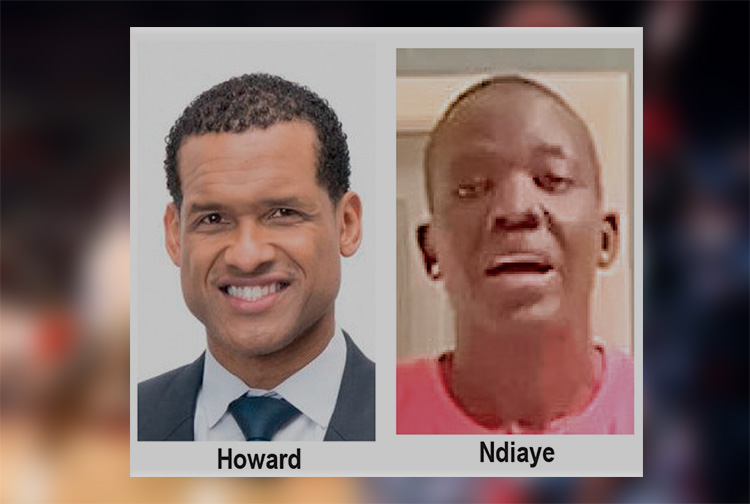
The U.S. Embassy in Colombo welcomed the U.S. Sports Envoys to Sri Lanka, former National Basketball Association (NBA) and Women’s National Basketball Association (WNBA) players Stephen Howard and Astou Ndiaye, from June 8 through 14.
The Public Diplomacy section of the U.S. Embassy said that it would launch a weeklong basketball program intended to harness the unifying power of sports, made possible through collaboration with Foundation of Goodness and IImpact Hoop Lab.
While in Sri Lanka, Howard and Ndiaye, both retired professional basketball players, will conduct a weeklong program, Hoops for Hope: Bridging Borders through Basketball. The Sports Envoys will lead basketball clinics and exhibition matches and engage in leadership sessions in Colombo and Southern Province for youth aged 14-18 from Northern, Uva, Eastern and Western Provinces, offering skills and leadership training both on and off the court. The U.S. Envoys will also share their expertise with the Sri Lanka Basketball Federation, national coaches, and players, furthering the development of basketball in the country. Beyond the clinics, they will collaborate with Sri Lankan schoolchildren to take part in a community service project in the Colombo area.
“We are so proud to welcome Stephen and Astou as our Sports Envoys to Sri Lanka, to build on the strong people-to-people connections between the United States and Sri Lanka,” said U.S. Ambassador Julie Chung. “The lessons that will be shared by our Sports Envoys – communication, teamwork, resilience, inclusion, and conflict resolution – are essential for leadership development, community building, equality, and peace. The U.S. Sports Envoy program is a testament to our belief that sports can be a powerful tool in promoting peace and unity.”
News
Rahuman questions sudden cancellation of leave of CEB employees
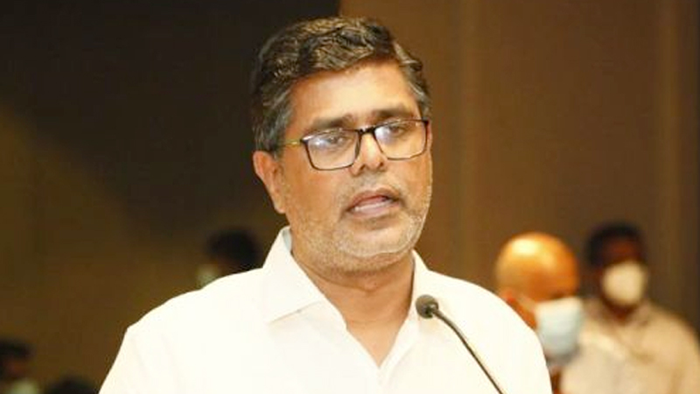
SJB Colombo District MP Mujibur Rahuman in parliament demanded to know from the government the reasons for CEB suspending the leave of all its employees until further notice from Thursday.
MP Rahuman said that the CEB has got an acting General Manager anew and the latter yesterday morning issued a circular suspending leave of all CEB employees with immediate effect until further notice.
“We demand that Minister Kanchana Wijesekera should explain this to the House. This circular was issued while this debate on the new Electricity Amendment Bill was pending. There are many who oppose this Bill. The Minister must tell parliament the reason for the urge to cancel the leave of CEB employees,” the MP said.However, Speaker Mahinda Yapa Abeywardena prevented Minister Wijesekera responding to the query and said that the matter raised by MP Rahuman was not relevant.
News
CIPM successfully concludes 8th Annual Symposium
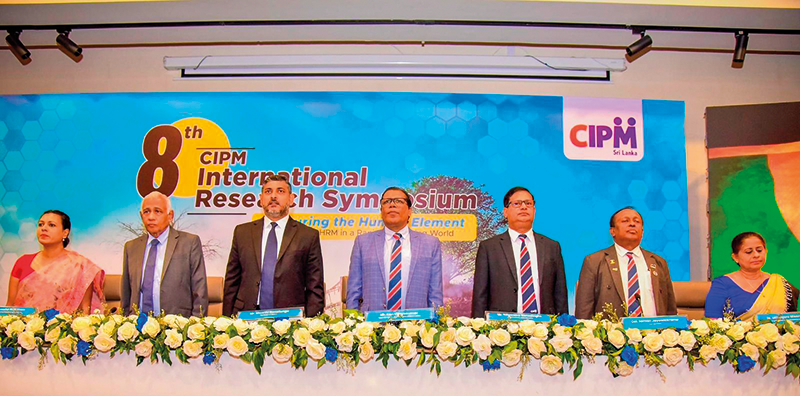
The Chartered Institute of Personnel Management (CIPM) successfully concluded the 8th Annual CIPM Symposium, which took place on 31st May 2024. Themed “Nurturing the Human Element—Redefining HRM in a Rapidly Changing World,” the symposium underscored the pivotal role of human resource management (HRM) in today’s dynamic global landscape. Since its inception in 1959, CIPM has been dedicated to advancing the HR profession through education, professional development, and advocacy, solidifying its position as Sri Lanka’s leading professional body for HRM.
Ken Vijayakumar, the President of the CIPM, graced the occasion as the chief guest. The symposium commenced with the welcome address by the Chairperson, Prof. Arosha Adikaram, followed by the Web Launch of the Symposium Proceedings and Abstract Book by the CIPM President. The event featured distinguished addresses, including a speech by Chief Guest Ken Vijayakumar, President of CIPM, and an address by Guest of Honor Shakthi Ranatunga, Chief Operating Officer of MAS Holdings Pvt. Ltd., Sri Lanka.
The symposium also featured an inspiring keynote address by Prof. Mario Fernando, Professor of Management and Director of the Centre for Cross Cultural Management (CCCM) at the University of Wollongong, Australia.
Vote of Thanks of the inauguration session was delivered by Dr. Dillanjani Weeratunga, Symposium Co-chair.
The symposium served as a comprehensive platform for researchers to present their findings across a wide range of critical topics in HRM. These included Cultural Diversity and Inclusion, Talent Development and Retention, Ethical Leadership and Corporate Social Responsibility, Adapting to Technological Advancements, Mental Health and Well-being at Work, Global Workforce Challenges, Employee Empowerment, and Reskilling and Upskilling.
The plenary session was led by Prof. Wasantha Rajapakse. Certificates were awarded to the best paper presenters during the valedictory session, followed by a vote of thanks delivered by Kamani Perera, Manager of Research and Development.
The annual symposium of CIPM was a truly inclusive event, attracting a diverse audience that spanned undergraduates, graduates, working professionals, research scholars and lecturers. This widespread interest highlights the symposium’s significance in the field of HRM, offering a unique opportunity for everyone to network and learn from scholarly brains.The CIPM International Research Symposium was sponsored by Hambantota International Port, Sri Lanka Institute of Information Technology (SLIIT), E B Creasy & Co. PLC, and Print Xcel Company.


